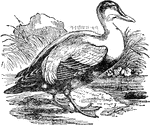Clipart tagged: ‘sea-duck’

The Bill of an Eider
"Somateri mollissima. Somateri dresseri. Common Eider. Bill gibbous at base of upper mandible; outline…

Eider Duck
The Common Eider, Somateria mollissima, is a large (50-71cm body length) sea-duck, which is distributed…